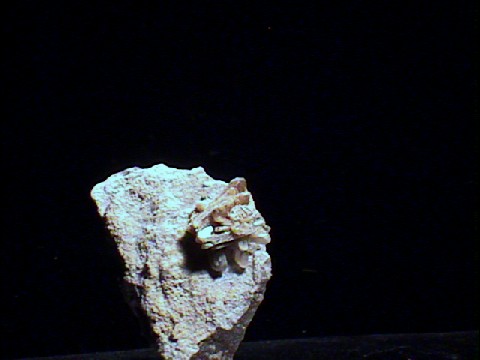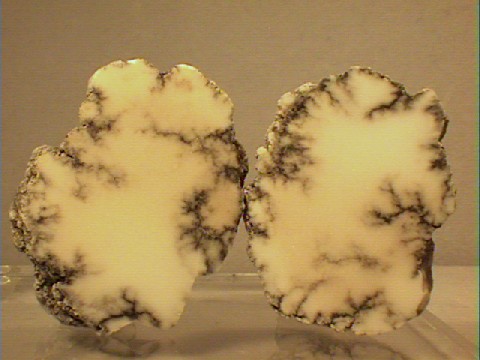 The mineral HOWLITE
The mineral HOWLITE
- Chemistry: Ca2B5SiO9(OH)5, Calcium Boro-silicate Hydroxide.
- Classes: Silicates and Carbonates
- Subclasses: Nesosilicates and Borates
- Uses: As a source of boron, as an ornamental stone for carved beads, figurines and polished cabochons, as a turquoise substitute and as mineral specimens.
Specimens
Howlite, which is named for its discoverer Henry How (a Nova Scotia geologist), is one of those minerals that is more famous for imitating another mineral. In this case the other mineral is turquoise, a phosphate gemstone. Although howlite is always white or gray, it can accept dyes fairly easily and be dyed a turquoise blue. The look of turquoise is so good that dishonest dealers have been unfortunately successful at this hoax. In more honest circumstances, dyed howlite is an affordable substitute for turquoise carvings, beads, polished stones and cabochons. It accepts a nice polish and its porcelaneous luster is attractive and enhances even undyed beads and carvings. Unfortunately it has low hardness, but it still has a distinct toughness. California is the source for almost all of the howlite trade where nodules of up to one hundred pounds have been found.
Howlite is found in continental evaporite deposits with other borate and evaporite minerals. It forms in nodules that appear like the heads of cauliflower, crystals faces on the nodules are rare. Veins of black web-like streaks often are interlaced throughout the nodules, adding to their character. Slabs of howlite are often painted with scenes and designs that make artistic use of these veins. Datolite and bakerite, two other boro-silicates, form similar looking nodules, but are distinctively harder. Massive magnesite can also be confused with howlite, but it has good cleavage.
Howlite as is listed above is often a confusing mineral to classify. The silicon atom in its formula would normally require its classification as a silicate mineral. But some classification schemes prefer to place howlite with other borate minerals in the carbonates class because it has five borons to only one silicon and its character and formation are more in line with other borate minerals such as colemanite, ulexite, borax and kernite.
PHYSICAL CHARACTERISTICS:
- Color is white with gray to black streaks, web-like markings and blotches.
- Luster is dull to sub-vitreous (porcelaneous) and earthy.
- Transparency crystals are opaque to translucent.
- Crystal System is monoclinic; 2/m
- Crystal Habits include cauliflower-like nodules and compact sometimes micaceous masses. Crystals are rare, but minute (1mm size) tabular six sided crystals sometimes aggregated into rosettes are found and some nodules will have crystal faces on their surfaces (mostly from Nova Scotia).
- Cleavage is absent.
- Fracture is conchoidal to uneven.
- Hardness is 3.5
- Specific Gravity is approximately 2.5 - 2.6 (slightly below average)
- Streak is white.
- Other Characteristics: Sometimes fluoresces a blue, yellowish white or off white color under shortwave UV light and dissolves in hydrochloric acid solution without bubbling.
- Associated Minerals include colemanite, ulexite, anhydrite, gypsum, colemanite and clays.
- Notable Occurrences include Latonville Quarry, Brookville, Windsor (the type locality) and Iona, Nova Scotia; Newfoundland and New Brunswick, Canada; Sterling Borax Mine, Tick Canyon and Lang, Los Angeles County; Gower Gulch, Inyo County and Daggett, San Bernardino County and other borate deposits in California, USA.
- Best Field Indicators are nodular character, color, solubility in HCl, luster, lack of cleavage and softness.







